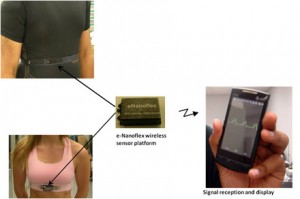Have they thought about the sweat? Engineers at the University of Arkansas have developed garments (a sports bra for women and a vest for men) than can monitor their physiological responses and track their location. From May 3, 2012 news release on the University of Arkanasa newswire page,
An interdisciplinary team of engineers at the University of Arkansas has developed a wireless health-monitoring system that gathers critical patient information, regardless of the patient’s location, and communicates that information in real time to a physician, hospital or the patient herself.
The system includes a series of nanostructured, textile sensors integrated into a conventional sports bra for women and vest for men. Via a lightweight and wireless module that snaps onto these garments, the sensors communicate with system software that relies on a smart phone to collect information, compress it and send it over a variety of wireless networks.
“Our e-bra enables continuous, real-time monitoring to identify any pathophysiological changes,” said Vijay Varadan, Distinguished Professor of electrical engineering. “It is a platform on which various sensors for cardiac-health monitoring are integrated into the fabric. The garment collects and transmits vital health signals to any desired location in the world.”
The system monitors blood pressure, body temperature, respiratory rate, oxygen consumption, some neural activity and all the readings provided by a conventional electrocardiograph (ECG), including the ability to display inverted T waves, which indicate the onset of cardiac arrest. The system does not require a cuff or any extra accessories to measure blood pressure and could therefore replace conventional blood-pressure monitors. It could also replace the cumbersome combination of ECG sensors and wires attached to patients while they walk on treadmills.
The researchers have provided this image,

The wireless monitoring system includes sensors, integrated into garments, that communicate health information to smart phones.
Here’s a bit more about the technology (from the May 3, 2012 news release),
The sensors, which are smaller than a dime, include gold nanowires, as well as flexible, conducting textile nanosensors. The sensors are made of arrays of gold nano-electrodes fabricated on a flexible substrate. The textile sensors are woven into the bra material. These sensors do not require conventional sticky electrodes or the use of gel.
Electrical signals and other physiological data gathered by the sensors are sent to the snap-on wireless module, the contents of which are housed in a plastic box that is slightly smaller than a ring box. As the critical wireless component, the module is essentially a low-powered laptop computer that includes an amplifier, an antenna, a printed circuit board, a microprocessor, a Bluetooth module, a battery and various sensors. The size of the module depends heavily on power consumption and minimum battery size. Varadan said that anticipated battery and Bluetooth upgrades will allow the researchers to build a smaller – 1.5 inches long, 0.75 inch wide and 0.25 inch deep – lighter and flexible module that will replace the rigid box.
Researchers are considering other applications for this technology (from the May 3, 2012 news release),
Data from the sensors then stream to commercially available cell phones and hand-held devices, which expand the use of the system beyond health care. By carrying a cell phone, athletes can monitor all signs mentioned above and other metrics, such as number of calories burned during a workout. To render clean data, the software includes filtering algorithms to mitigate problems due to motion of the hand-held device during exercise.
In light of the suggestion that this could be used by athletes I’m repeating my rhetorical question, have they thought about the sweat?
Thanks to Nanowerk where I first found out about this research at the University of Arkansas in their May 4, 2022 news item.